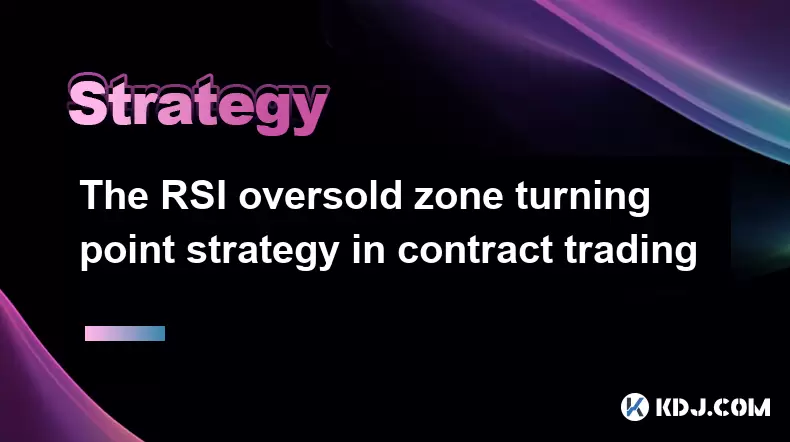-
 bitcoin
bitcoin $123963.239194 USD
1.37% -
 ethereum
ethereum $4529.082464 USD
1.07% -
 xrp
xrp $2.983640 USD
0.71% -
 tether
tether $1.000287 USD
0.02% -
 bnb
bnb $1179.874393 USD
2.99% -
 solana
solana $230.633678 USD
1.55% -
 usd-coin
usd-coin $0.999835 USD
0.03% -
 dogecoin
dogecoin $0.254240 USD
1.34% -
 tron
tron $0.341176 USD
0.15% -
 cardano
cardano $0.842285 USD
0.52% -
 hyperliquid
hyperliquid $48.537896 USD
-0.86% -
 chainlink
chainlink $21.863092 USD
-0.84% -
 ethena-usde
ethena-usde $0.999743 USD
-0.07% -
 sui
sui $3.579561 USD
-0.18% -
 stellar
stellar $0.403418 USD
2.67%
The RSI oversold zone turning point strategy in contract trading
RSI helps identify turning points in crypto contract trading, especially in the oversold zone below 30, signaling potential price reversals for strategic market entry.
Jun 03, 2025 at 01:21 pm

The RSI (Relative Strength Index) is a popular momentum oscillator used in technical analysis to measure the speed and change of price movements. When it comes to contract trading within the cryptocurrency market, the RSI can be particularly useful in identifying potential turning points, especially in the oversold zone. This strategy focuses on utilizing the RSI to pinpoint moments when a cryptocurrency might be due for a price reversal, offering traders opportunities to enter the market at potentially advantageous positions.
Understanding the RSI and Oversold Zones
The RSI is calculated using the average gains and losses of an asset over a specific period, typically 14 days. The resulting value ranges from 0 to 100. An RSI value below 30 is generally considered to be in the oversold zone, indicating that the asset may be undervalued and could be poised for a price increase. Conversely, an RSI above 70 is considered overbought, suggesting that the asset might be overvalued and due for a price decrease.
In contract trading, understanding these zones can help traders make informed decisions about when to enter or exit trades. The focus of this strategy is on the oversold zone, as it can signal a potential buying opportunity.
Identifying the Oversold Zone Turning Point
To effectively use the RSI oversold zone turning point strategy, traders need to be vigilant in monitoring the RSI values of the cryptocurrencies they are interested in. Here's how to identify a potential turning point in the oversold zone:
- Monitor the RSI closely: Keep an eye on the RSI values of your chosen cryptocurrency. When the RSI dips below 30, it enters the oversold zone.
- Look for divergence: Pay attention to any divergence between the RSI and the price action. If the price continues to drop but the RSI starts to rise, this could be a sign of an impending reversal.
- Watch for RSI crossing back above 30: A key signal for a potential turning point is when the RSI moves back above 30 after being in the oversold zone. This crossover can indicate that the selling pressure is diminishing and a price increase may follow.
Executing the Strategy in Contract Trading
Once you have identified a potential turning point in the oversold zone, the next step is to execute the strategy in your contract trading. Here's a detailed guide on how to proceed:
- Choose your contract: Select the cryptocurrency contract you wish to trade. Ensure that it is one that you have been monitoring and that has shown an RSI value below 30.
- Set your entry point: Decide on your entry point based on the RSI crossover. You might choose to enter the trade as soon as the RSI crosses back above 30, or you might wait for additional confirmation, such as a bullish candlestick pattern or a break above a key support level.
- Determine your position size: Calculate your position size based on your risk tolerance and the amount of capital you are willing to allocate to the trade.
- Set your stop-loss: Place a stop-loss order to limit potential losses. A common approach is to set the stop-loss just below the recent low that occurred while the RSI was in the oversold zone.
- Monitor the trade: Keep an eye on the trade's performance and the RSI values. Be prepared to adjust your stop-loss or take-profit levels based on new market developments.
Risk Management in the RSI Oversold Zone Strategy
Risk management is crucial when employing the RSI oversold zone turning point strategy in contract trading. Here are some key considerations:
- Diversify your trades: Don't put all your capital into one trade. Spread your investments across different cryptocurrencies to mitigate risk.
- Use appropriate leverage: Be cautious with leverage, as it can amplify both gains and losses. Only use leverage that you are comfortable with and that aligns with your risk management strategy.
- Stay disciplined: Stick to your trading plan and avoid making impulsive decisions based on short-term market fluctuations. The RSI is a tool to guide your decisions, but it should not be the sole factor in your trading strategy.
Backtesting and Refining the Strategy
To increase the effectiveness of the RSI oversold zone turning point strategy, it's essential to backtest and refine your approach. Here's how to do it:
- Historical data analysis: Use historical price data to test how the strategy would have performed in the past. Look for instances where the RSI entered the oversold zone and subsequently crossed back above 30, noting the outcomes of these trades.
- Adjust parameters: Experiment with different RSI periods (e.g., 10 days, 20 days) to see if shorter or longer periods yield better results for your trading style.
- Incorporate additional indicators: Consider combining the RSI with other technical indicators, such as moving averages or the MACD, to enhance your entry and exit signals.
- Keep a trading journal: Document your trades, including the RSI values at entry and exit points, the outcomes, and any lessons learned. This can help you refine your strategy over time.
Real-World Application and Examples
To illustrate the RSI oversold zone turning point strategy in action, let's consider a hypothetical example involving Bitcoin (BTC) futures contracts:
- Scenario: Bitcoin has been experiencing a downtrend, and the RSI has dipped below 30, indicating an oversold condition.
- Observation: As the price continues to fall, you notice that the RSI starts to rise, showing divergence from the price action.
- Entry point: The RSI crosses back above 30, and you decide to enter a long position on a BTC futures contract.
- Trade management: You set your stop-loss just below the recent low and monitor the trade. As the price begins to recover, you adjust your stop-loss to lock in profits.
- Outcome: The price of Bitcoin rebounds, and your trade results in a profit.
This example demonstrates how the RSI oversold zone turning point strategy can be applied in real-world contract trading scenarios, highlighting the importance of monitoring the RSI and price action closely.
Frequently Asked Questions
Q1: Can the RSI oversold zone strategy be used for short-term trading?Yes, the RSI oversold zone strategy can be adapted for short-term trading by using shorter RSI periods, such as 7 or 10 days, and focusing on intraday price movements. However, short-term trading typically involves higher risk and requires more frequent monitoring of the market.
Q2: Is it necessary to use other indicators alongside the RSI in this strategy?While the RSI can be used as a standalone indicator, combining it with other technical indicators, such as moving averages or the MACD, can provide additional confirmation and enhance the reliability of your trading signals.
Q3: How can I avoid false signals when using the RSI oversold zone strategy?To minimize false signals, look for additional confirmation from other indicators or price patterns. For example, a bullish candlestick pattern or a break above a key support level can provide added confidence in a potential turning point.
Q4: Can this strategy be applied to other financial markets besides cryptocurrencies?Yes, the RSI oversold zone turning point strategy can be applied to other financial markets, such as stocks, forex, and commodities. However, the effectiveness of the strategy may vary depending on the specific characteristics and volatility of each market.
Disclaimer:info@kdj.com
The information provided is not trading advice. kdj.com does not assume any responsibility for any investments made based on the information provided in this article. Cryptocurrencies are highly volatile and it is highly recommended that you invest with caution after thorough research!
If you believe that the content used on this website infringes your copyright, please contact us immediately (info@kdj.com) and we will delete it promptly.
- BlockDAG, DOGE, HYPE Sponsorship: Crypto Trends Shaping 2025
- 2025-10-01 00:25:13
- Deutsche Börse and Circle: A StableCoin Adoption Powerhouse in Europe
- 2025-10-01 00:25:13
- BlockDAG's Presale Buzz: Is It the Crypto to Watch in October 2025?
- 2025-10-01 00:30:13
- Bitcoin, Crypto, and IQ: When Genius Meets Digital Gold?
- 2025-10-01 00:30:13
- Stablecoins, American Innovation, and Wallet Tokens: The Next Frontier
- 2025-10-01 00:35:12
- NBU, Coins, and Crypto in Ukraine: A New Yorker's Take
- 2025-10-01 00:45:14
Related knowledge

Practical parameter settings for a Bitcoin multi-timeframe moving average system
Sep 18,2025 at 10:54pm
Optimizing Timeframe Combinations for Bitcoin Trading1. Selecting appropriate timeframes is crucial when building a multi-timeframe moving average sys...

How can I filter out false breakouts in Dogecoin high-frequency trading?
Sep 22,2025 at 01:00am
Understanding False Breakouts in Dogecoin Trading1. A false breakout occurs when Dogecoin's price appears to move beyond a defined support or resistan...

Techniques for identifying tops and bottoms in the Bitcoin on-chain NVT model
Sep 20,2025 at 07:54pm
Understanding the NVT Model in Bitcoin Analysis1. The Network Value to Transactions (NVT) ratio is often described as the 'P/E ratio' of the cryptocur...

What does the surge in open interest in Bitcoincoin futures mean?
Sep 20,2025 at 11:18pm
Understanding the Surge in Dogecoin Futures Open Interest1. A surge in open interest within Dogecoin futures indicates a growing number of active cont...

How can I use the Ethereum USDT premium to gauge market sentiment?
Sep 18,2025 at 11:55pm
Understanding the Ethereum USDT Premium1. The Ethereum USDT premium refers to the price difference between USDT (Tether) traded on Ethereum-based plat...

What should I do if Ethereum staking yields decline?
Sep 20,2025 at 06:18am
Understanding the Causes Behind Declining Ethereum Staking Yields1. The Ethereum network transitioned to a proof-of-stake consensus mechanism with the...

Practical parameter settings for a Bitcoin multi-timeframe moving average system
Sep 18,2025 at 10:54pm
Optimizing Timeframe Combinations for Bitcoin Trading1. Selecting appropriate timeframes is crucial when building a multi-timeframe moving average sys...

How can I filter out false breakouts in Dogecoin high-frequency trading?
Sep 22,2025 at 01:00am
Understanding False Breakouts in Dogecoin Trading1. A false breakout occurs when Dogecoin's price appears to move beyond a defined support or resistan...

Techniques for identifying tops and bottoms in the Bitcoin on-chain NVT model
Sep 20,2025 at 07:54pm
Understanding the NVT Model in Bitcoin Analysis1. The Network Value to Transactions (NVT) ratio is often described as the 'P/E ratio' of the cryptocur...

What does the surge in open interest in Bitcoincoin futures mean?
Sep 20,2025 at 11:18pm
Understanding the Surge in Dogecoin Futures Open Interest1. A surge in open interest within Dogecoin futures indicates a growing number of active cont...

How can I use the Ethereum USDT premium to gauge market sentiment?
Sep 18,2025 at 11:55pm
Understanding the Ethereum USDT Premium1. The Ethereum USDT premium refers to the price difference between USDT (Tether) traded on Ethereum-based plat...

What should I do if Ethereum staking yields decline?
Sep 20,2025 at 06:18am
Understanding the Causes Behind Declining Ethereum Staking Yields1. The Ethereum network transitioned to a proof-of-stake consensus mechanism with the...
See all articles










































































